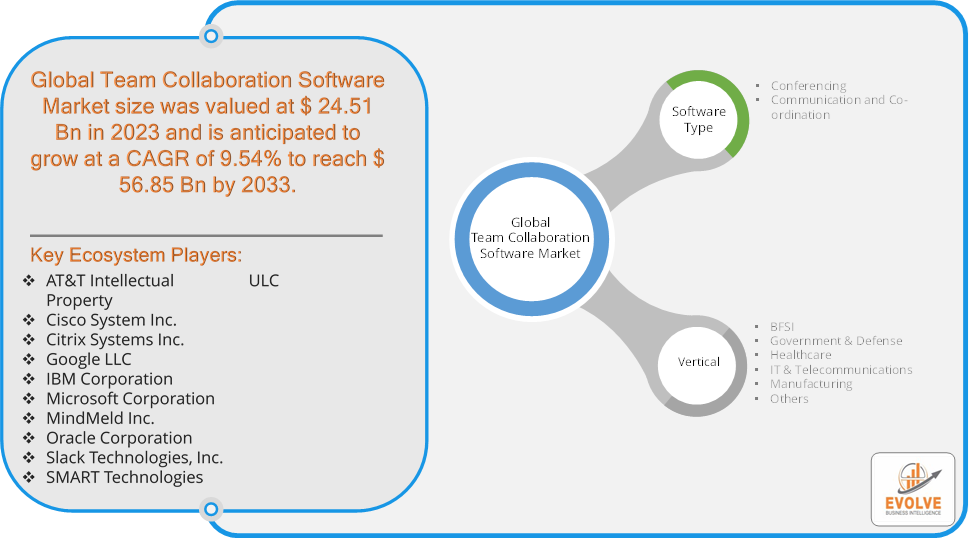Blog
Team Collaboration Software Market Grows: 9.54% CAGR

Evolve Business Intelligence has published a research report on the Global Team Collaboration Software Market, 2023–2033. The global Team Collaboration Software Market is projected to exhibit a CAGR of around 9.54% during the forecast period of 2023 to 2033.
Evolve Business Intelligence has recognized the following companies as the key players in the global Team Collaboration Software Market: AT&T Intellectual Property, Cisco System Inc., Citrix Systems Inc., Google LLC, IBM Corporation, Microsoft Corporation, MindMeld Inc., Oracle Corporation, Slack Technologies Inc. and SMART Technologies ULC.
 More Information: https://evolvebi.com/report/team-collaboration-software-market-analysis/
More Information: https://evolvebi.com/report/team-collaboration-software-market-analysis/
Market Highlights
The Global Team Collaboration Software Market is projected to be valued at USD 56.85 Billion by 2033, recording a CAGR of around 9.54% during the forecast period. The Team Collaboration Software Market refers to the industry focused on the development, distribution, and use of software solutions designed to facilitate communication, coordination, and collaboration among teams, whether they are working in the same location or remotely. These software solutions are essential for enhancing productivity and ensuring that team members can work together efficiently, even when they are geographically dispersed.
The Team Collaboration Software Market is expected to grow as businesses increasingly rely on digital tools to enhance team productivity and communication in a rapidly evolving work environment.
The COVID-19 pandemic had a significant impact on the Team Collaboration Software Market. As lockdowns and social distancing measures were implemented globally, many organizations rapidly transitioned to remote work. This created an urgent need for effective team collaboration tools to maintain productivity and communication. With the increased use of collaboration tools, concerns about data security and privacy grew. This led to the introduction of more robust security measures, such as end-to-end encryption and secure access controls. The pandemic forced a broad range of industries, including education, healthcare, and government, to adopt team collaboration software. This widened the user base beyond traditional corporate environments. The pandemic normalized virtual meetings as a standard form of communication, reducing the reliance on in-person meetings and business travel. The surge in demand attracted new entrants into the market, leading to increased competition. Companies that previously offered different types of software pivoted to include collaboration features. The pandemic opened up opportunities for collaboration software providers to expand into new markets and demographics, particularly in regions and sectors that were previously underpenetrated.
Segmental Analysis
The global Team Collaboration Software Market has been segmented based on Software Type and Industry Vertical.
Based on Software Type, the Team Collaboration Software Market is segmented into Conferencing, Communication and Co-ordination. The Communication and Co-ordination segment is anticipated to dominate the market.
Based on Industry Vertical, the global Team Collaboration Software Market has been divided into BFSI, Government & Defense, Healthcare, IT & Telecommunications, Manufacturing and Others. The IT & Telecommunications segment is anticipated to dominate the market.
More Information: https://evolvebi.com/report/team-collaboration-software-market-analysis/
Regional Analysis
The Team Collaboration Software Market is divided into five regions: North America, Europe, Asia-Pacific, South America, and the Middle East, & Africa. North America, particularly the United States, is one of the largest and most mature markets for team collaboration software. The region’s early adoption of digital technologies, advanced IT infrastructure, and widespread remote work practices drive market growth. Europe region countries like the UK, Germany, and France, has seen significant adoption of collaboration tools, driven by the shift towards remote and hybrid work. The region also benefits from strong IT infrastructure and a high level of digital literacy. The General Data Protection Regulation (GDPR) in Europe is a major consideration, driving the demand for secure and compliant collaboration solutions. This focus on data privacy creates opportunities for vendors offering robust security features. Asia-Pacific is one of the fastest-growing regions in the team collaboration software market, driven by the rapid digitalization of businesses, increasing internet penetration, and the growing adoption of remote work practices. Latin America is an emerging market with growing demand for team collaboration software, particularly in countries like Brazil, Mexico, and Argentina. The region’s increasing focus on digital transformation and remote work is driving adoption. Cost considerations are significant in this region, leading to a preference for affordable and scalable collaboration tools that can cater to the needs of SMEs. The Middle East and Africa (MEA) region is witnessing gradual adoption of team collaboration software, driven by the increasing penetration of digital technologies and the growing trend of remote work, particularly in urban centers.



